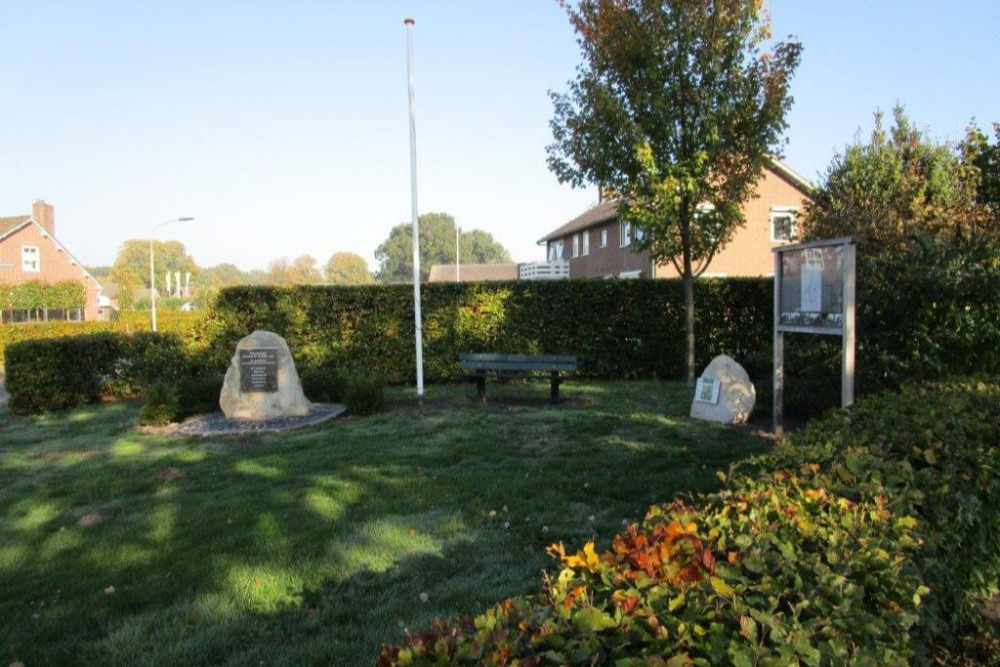Liberation Route Marker 604: A bittersweet liberation
A bittersweet liberation
After more than 700 paratroopers jump out over Drenthe during the night of April 7 to April 8, 1945, the liberation of the northern part of the Netherlands proceeds rapidly. The following days, battles are fought in the area against German troops, who offer heavy resistance at times, but thanks to the air support more and more villages and hamlets are liberated.
On April 12, attacks on Assen are launched from Beilen to break through to Groningen. This task is assigned to the Essex Scottish Regiment of the 4th Infantry Brigade of the 2nd Canadian Infantry Division. Tanks of the ‘B’ Squadron of the 10th Armoured Regiment, The Fort Garry Horse of the 2nd Independent Canadian Armoured Brigade provide support throughout this campaign. In the early morning, the thunderous roar of the advancing Infantry Brigade’s canons and tanks can be heard from afar in Hooghalen.
A reconnaissance plane circles the village for a long time as well. At half past seven, the first grenades are dropped killing a German motorcyclist. In the pine forest south of the village, the Germans have dug in and offer fierce resistance. After the resistance is eliminated, the battle shifts to the centre of the village. About forty German soldiers have taken up positions in people’s homes and farms. The battle is fierce and there are casualties on both sides. When the Germans finally retreat, they set fire to the farms’ thatched roofs. Fortunately, the local population is spared, but many farms go up in flames. The old characteristic image of the village will never be the same.
Audiospot - A bittersweet liberation
Liberation Route Europe is a certified Cultural Route of the Council of Europe. With hundreds of sites and stories in nine European countries, the route links the main regions along the advance of the Allied Forces in 1943-1945.
The entire route consists of themed routes that can be travelled by by hiking, walking, cycling and car. These routes pass numerous historical and interesting sites and tell stories from a multitude of perspectives that were important in the final phase of World War II.
Many routes feature listening spots, offering the opportunity to listen to a historical story at a location. In addition, many ‘Vectors of Memory’ have been placed, indicating that the passer-by is on one of the Liberation Routes.
The routes can be found on the Liberation Route Europe website or in the app through which many stories can also be listened to.
Do you have more information about this location? Inform us!
Source
- Text: TracesOfWar & Liberation Route Europe
- Photos: Herma de Vries (1, 2), Arie van Wijngaarden (3)
Nearby
Museum
- Camp Westerbork Remembrance Centre - Hooghalen
- Stoottroepenmuseum - Johan Willem Frisokazerne - Assen
Point of interest
- Bullet Holes Hoofdstraat 5 - Hooghalen
- The Westerbork path - Hooghalen
- Bomb Craters Zuid Hijkerzand - Hijken
Monument
- Monument Canadian Soldiers Hooghalen - Hooghalen
- Reminder Bench Lubbe Boxem Hooghalen - Hooghalen
- Memorial Werkman-Poort Camp Westerbork - Hooghalen
Cemetery
- Dutch War Grave Communal Cemetery Hijken - Hijken
- Jewish War Graves Twijfelveld - Assen
- Dutch War Grave De Boskamp Cemetery - Assen
Remembrance Stone
- Stumbling Stone Laaghalerveen - Laaghalerveen
- Stumbling Stone Oranjekanaal Noordzijde 12 - Zwiggelte
- Stumbling Stone & Memorial De Haar 5 - Assen
Fortification
- German Anti-tank Ditch Zuid Hijkingerzand - Hijken
- German Antitank Ditch Assen - Assen
- German Antitank Ditch Assen - Assen





